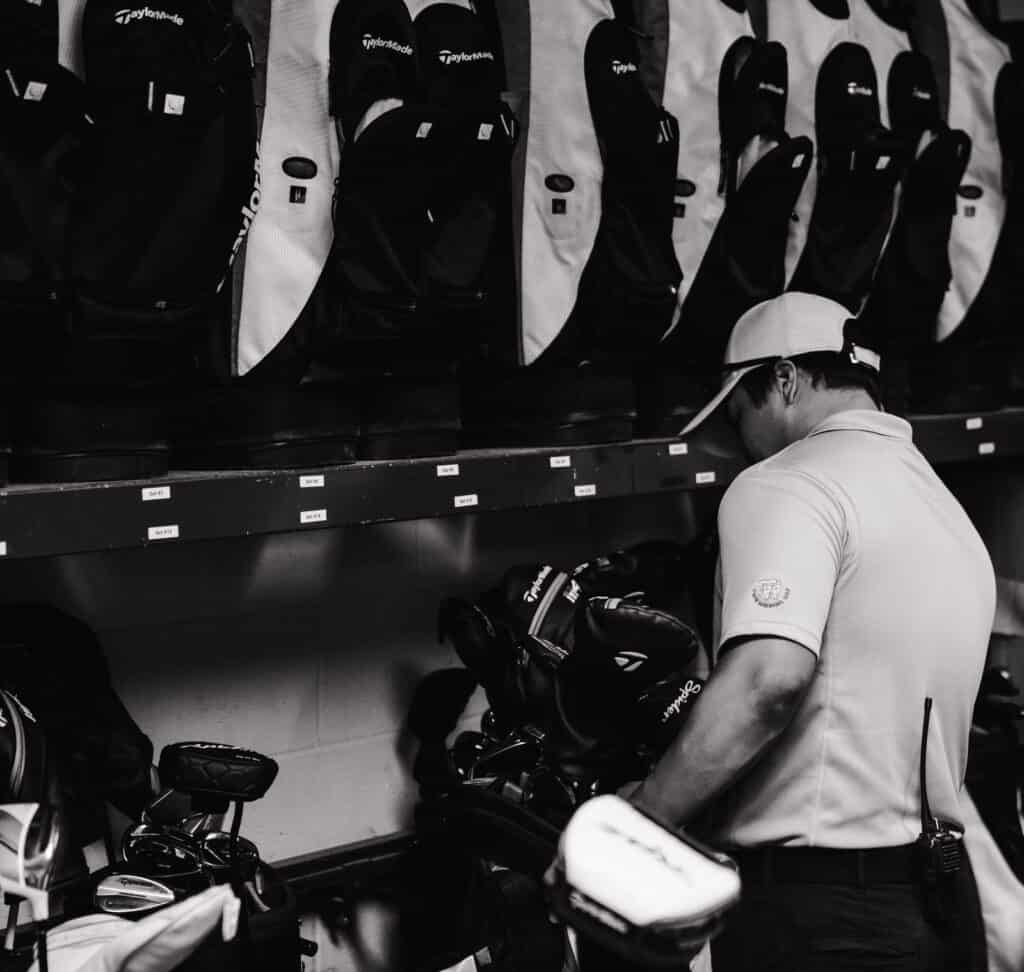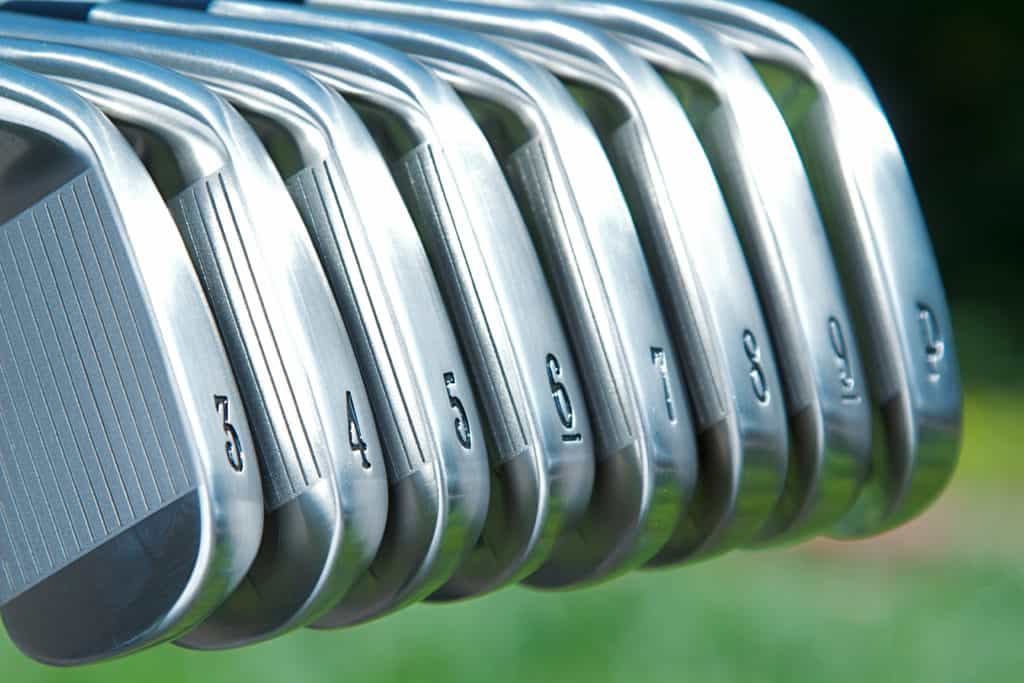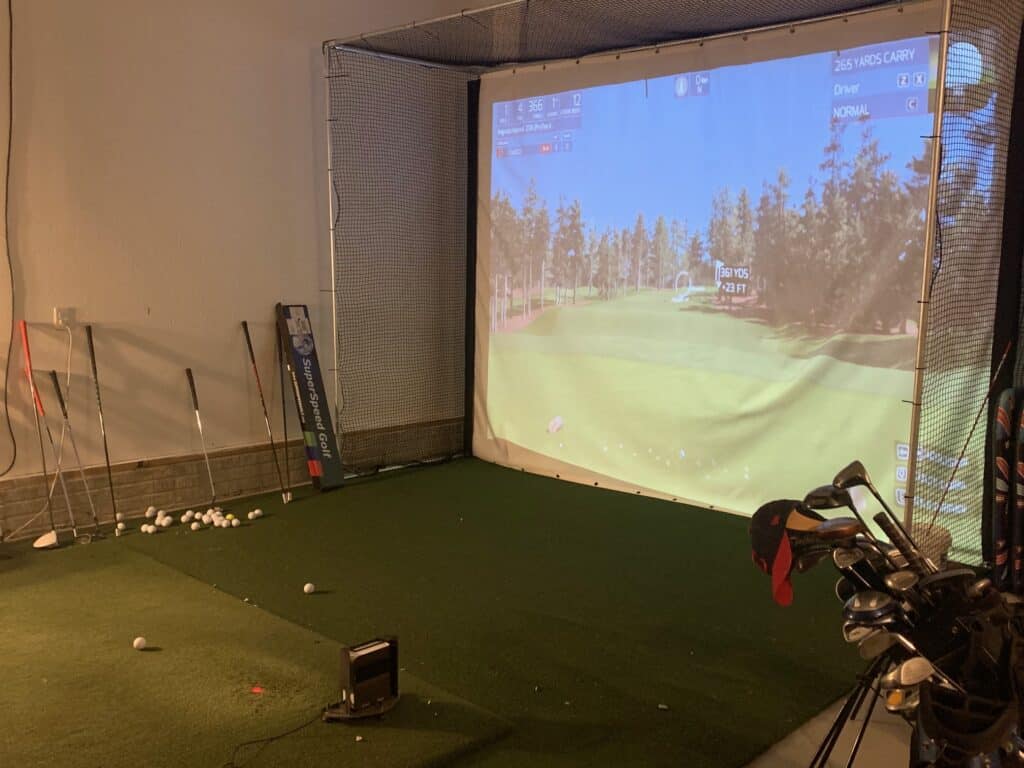Golfers get to carry 14 clubs in their bag and it is highly recommended to make sure they have the best 14 clubs for their game.
Too often high handicap golfers default to a standard bag setup that has been used for years. They will often carry a 3-9 iron, pitching wedge, sand wedge, lob wedge, driver, 3 wood, 5 wood, putter.
While this might work for some high handicap golfers, I would recommend completing an a quick assessment of your game using the questions below and then consider some of the recommendations on clubs you can swap out that might improve your game.
We then answer many of the frequently asked questions about clubs in the bag for a high handicap golfer.

High Handicap Bag Setup
The golfer should complete a quick assessment of strengths and weaknesses in his or her game and then consider what clubs might be worth swapping out. With golfers having different strengths or weaknesses, it is nearly impossible to just say, “every golfer should carry these clubs.”
When a golfer is considering his or strengths and weaknesses, we would refer them back to what we believe are the 3 fundamentals in golf.
- Low Point Control: Is the golfer able to control the low point and strike the ball solid a high percentage of the time? Or do they constantly hit the ball fat or thin.
- Start Line and Curve Control: Can the golfer start the ball on the intended start line and control the curve of the ball? Or is the shot pattern all over the place?
- Speed and Distance: Does the golfer have enough swing speed to play the course below his or her current handicap level?
(See drills below for all three of the fundamentals listed)
Here are some questions to help answer what might be holding you back:
- Are you struggling off the tee with the driver: distance or accuracy?
- Are you struggling from 170 yards and further?
- Are you struggling to hit the green consistently from 115 yards and in?
- Are you struggling to chip the ball on the green and give yourself a chance to make the putt?
- Are you frequently 3 putting or missing putts inside of 5 feet?
If you answered yes to question 1:
- Your driver might not have enough loft or you have the wrong shaft. You need to keep a driver in your bag, but you might simply have the wrong driver. I would recommend investing the money in a quality driver and spending the resources to get fitted. This is a key club in your bag!
If you answered yes to question 2:
- You are more than likely struggling with your mid to long irons. The solution here is to consider hybrids. This would be even a higher recommendation for the golfer that has swing speed. If you have the swing speed and aren’t hitting the ball solid, see drill #1 below!
If you answered yes to question 3:
- You might need to add another wedge or two to your bag. A common setup for a pitching wedge, sand wedge and lob wedge might leave too large of a gap. Instead, you can consider a 48 degree pitching wedge, a 52 degree gap wedge, a 56 degree sand wedge and a 60 degree lob wedge. A high percentage of shots takes place inside of this distance. Dial in your distance, but first get the right wedge setup!
If you answered yes to question 4:
- Do you have a sand wedge and a lob wedge? Some golfer will say, “I will invest in more wedges when I get better.” I would recommend buying those wedges now as they keep the game more fun when you can chip the ball on the green consistently. A sand wedge and a lob wedge are essential clubs in any golfers bag from the highest of handicap golfers to the best professionals.
If you answered yes to question 5:
- It might be time to consider a different putting option. Did you pick up your putter in a garage sale? Or did you pick one out that looked good, felt good and helped you start the ball on the proper start line?
5 Golf Tips for High Handicappers!

Frequently Asked Questions About Bag Setup for High Handicap Golfers
Should a high handicapper carry a lob wedge?
Yes, with the way courses are setup (fast and firm) golfers should carry a 60 degree lob wedge. This will help on chip shots around the greens and those longer 40-50 yard shots that many high handicap golfers are often left with.
Should a high handicap golfer carry more hybrids?
It depends. Is swing speed the issue? Often times, for those with slower swing speeds, the hybrids are a great option If swing speed is holding your back, the hybrids could help greatly.
If you are struggling with low point control: see drill #1 below. If you are struggling with swing speed: you might want to check out #3 below on training for swing speed.
Golf Strategy for High Handicappers (5 Tips)
What degree wedges should a high handicap golfer carry?
They should consider carrying 4 wedges: a 48 degree pitching wedge, a 52 degree gap wedge, a 56 degree sand wedge, and a 60 degree lob wedge.
It is estimated that 60-65% of shots take place inside of 100 yards in golf. Make sure you have the right wedges and the right putter for your game!
Should a high handicap golfer get fitted for clubs?
If you have the resources, yes! It provides great confidence to know you have the right clubs. Keep in mind it isn’t going to take you from a 25 handicap to 10 overnight. You will still need to put in the time.
Complete Post: Does club fitting really help?

Drills or Training to Help With the 3 Fundamentals in Golf!
Drill #1: To Help With Low Point Control
- Take some yard paint and paint a 1-2 yard long line.
- Setup with 55% of your weight on your front side.
- Try to hit the target side of the line and see how many times out of 10 you can do this successfully!
- Repeat this drill every day for a month, tracking your progress and your ability to to this successfully in trials of ten.
- You may need to start with half swing and progress to full swings.
If you are struggling, put more weight forward and work on keeping your head still to help control the low point in the swing.
I would recommend using this drill as often as possible until you are able to stroke the ball with a 99% success rate. Some of the weakest golfers might only hit a ball solid 40-50% of the time. They will often strike one solidw, which keeps them coming back.
Keep using this drill and learn to control the very first fundamental in the golf swing: low point control!
How to Lower Handicap Fast! (10 Tips)
Drill #2: To Help With Start Line and Curve Control
- At the driving range, set up an alignment stick about 6-8 yards in front of you, straight down your target line.
- If you have a second alignment stick, set the stick 3-4 feet right of the first stick (for a draw) or left of the first stick (for a fade).
- Complete your initial assessment see how many times out of 10 you can start the ball to the right or left of your target. Pick one side and measure your game at this point.
- The goal is to eventually get 7 out of 10 shots to start to the correct side and draw back towards the target.
The combination of solid contact (low point control drill) and the ability to hit a stock shot (consistent curve) is the first step to really start reducing your golf score and handicap.

Training: To Help With Lack of Speed and Distance
The game of golf has evolved to where speed is important in the game of golf. The faster your swing, the further the ball flies and the more shorter irons or wedges you have into a green.
Training for speed is a great idea and one worth exploring!
My 50% swing example above can be a great swing because I have enough in my swing to still hit the ball far enough with the feel of a bunt swing.
If you are going to train for speed, I would highly recommend the SuperSpeed Training System.
Gone are the days of simply being content with the distance you currently hit your golf ball. Many older golfers have proven over the past several years that an increase in swing speed is possible.
There are training systems to help you get your game to the next level and distance is arguably the fastest way to make this happen!
My number one recommendation is to check out SuperSpeed Golf and their protocols to help you find a safe way to increase your swing speed.
I spent many years wondering how I can increase my swing speed. When I was playing junior golf, we weren’t fortunate enough to have some of the training aids and knowledge that is now available. Smart people have studied the golf swing and have created training aids and protocols to help all golfers increase their distance!
At around the same time, the statistics from the PGA Tour have become more clear and the importance of speed is acknowledged by many to be a key to being the best on the PGA Tour.
Within the past several years, there have been several products hit the market to make speed gains possible. While many people for many years waited for the latest driver to come out to gain an additional 5-10 yards, you can now do this even with your current clubs.
Did you know that with the SuperSpeed Training System you can gain 5-8% increase in swing speed as early as the first training session? This would allow you to gain somewhere between 10 and 30 yards depending on your current swing speed.
The SuperSpeed Training System is based on three different swing speed sticks all weighing at different weights. There is a green club that is 10% lighter than the average driver, the blue club which is 5% lighter and the red club which is actually 5% heavier!
Following their prescribed protocols the golfer completes the training every other day. The total time to complete most of their protocols is between 10-15 minutes. Most people can find the time to make this happen. The golfer will also need a swing radar to measure their progress.
The science behind the SuperSpeed Training System is based on overspeed training. Overspeed training has been around for several decades now and has been used by olympic athletics in the sport of Track and Field.
The science behind this overspeed training is based on the premise that your brain will only allow your body to move as fast as it feels it can stop safely! So, you get to work and swing the clubs as fast as possible, retraining your brain to allow you to swing your driver faster.
For more permanent results, the golfer should continue these training protocols for several months. The initial 5-8% is great and can become more permanent with the right length of training. The golfer can expect to continue to break down barriers every several months at a 1-2% increase.
My own experience has been an increase of 7-10 miles per hour on average from between 98-101 all the way up to 106-109. My goal is to hit the PGA Tour average of 113 mph in the coming months. I will continue to train every other day and watch in amazement as I am hitting drivers longer now than ever before!
Phil Mickelson (a senior golfer now) has been known to increase his swing speed in the past year or so and is close to 120 miles per hour in his swing speed. There are potential results for golfers of all ability levels and age!
Check the current price on SuperSpeed Golf System, here!
| Original Swing Speed | After 4-6 Weeks | New Carry Distance | Total Distance |
| 95 | 102 | 245 | 265 |
| 100 | 108 | 259 | 279 |
| 105 | 113 | 271 | 291 |
| 110 | 118 | 283 | 303 |
My Secret To Golf Improvement
Let’s face it, in order to get really good at golf, we must practice frequently. About three years ago, I made the leap and invested in a golf simulator build for my garage. I went with a SkyTrak Launch Monitor and the TGC software and can now play over 100,000 courses including Augusta, Pebble Beach, Bethpage Black, Whistling Straits. St. Andrews and many other of the top 100 courses in the world.
This golf simulator setup, which is more affordable that you might imagine, has been a game changer. I can now play golf everyday of the year regardless of rain, snow, cold weather or time of day. I can practice or play rounds of golf. I can stand in the 11th fairway at Augusta and with the auto-rewind feature I am able to practice my approach shots from various differences.
It is worth checking out through Rain or Shine Golf as they offer some incredible packages along with financing offers that are difficult to beat.
Some direct links to Rain or Shine Golf for pricing and financing:

Take Action – What You Can Do Today to Get Better
What does this mean for you? I believe in the following recipe to get better:
1 – Improve your motion in the golf swing by identifying a golf instructor. Here are some options:
Here is a list of golf instructors that we have reviewed:
2 – Train to swing faster and improve your swing speed. Here are some options:
Looking to gain more Speed and Distance in your swing. Two Options:
3 – Understand course strategy and work to break through your next barrier. Here is a series on breaking through:
We have provided guides on how to break 100, 90, 80 and 70. Check out more below, if interested.
4 – Practice Frequently
Did you know that I build a golf simulator in my garage and have played over 500 rounds of golf on my SkyTrak system? It has been a game changer and one worth checking out. Here are some of my other posts on golf simulators frequently asked questions:
- Is a Golf Simulator Worth It?
- How to Build a Golf Simulator?
- What is the Best Golf Simulator?
- Golf Simulator Accessories?
- How to Build a Golf Simulator for under $7000
- Top 11 Reasons to Buy a SkyTrak
- How to Build a Golf Simulator for Under $1000
- Why Build A Golf Simulator?
- What Space is Needed?
- Can A Golf Simulator Improve My Game?
- How Much Does A Golf Simulator Cost?
- Don’t Forget to Check out our 15 best golf swings of all time.
I am an amateur golfer on a journey to get better, enjoy the game as often as possible and share my passion and knowledge with others. I have coached high school golfers at a high level and have a great passion for the game and want to give back. I enjoy learning about the golf swing and am currently studying to be a certified professional golf instructor. Join me in our journey to get better everyday. Thank you for reading!

